The Sensoji Temple (金龍山浅草寺) in the Asakusa district is Tokyo’s best-visited attraction. Millions of tourists go here every year. It is a great place to be introduced to Japanese Buddhism, to buy souvenirs, and to eat delicious food.
But what makes the Sensoji Temple so interesting historically? What can you see and do here? And is this tourist temple worth a visit? In this article you will read all about it.
Looking for the best historical sights in Tokyo? You can read all about it in the Tokyo Historical Travel Guide.
*This article is also available in Dutch (Sensoji Tempel Reisgids)

In this Article about the Sensoji Temple
- History – Why a visit to the Sensoji Temple is historically interesting?
- How did the Sensoji Temple originate?
- Is this the oldest temple in Tokyo?
- Sights – What to see and do at Sensoji Temple?
- Kaminarimon gate
- Nakamise-Dori: Buying souvenirs in Tokyo’s oldest shopping street
- Hozomon Gate and the valuable treasury
- The prayer hall with the Golden Kannon?
- Discover the garden of the Asakusa Kannon Temple
- Review – To visit or not to visit the Sensoji Temple?
- Practical information: cost, opening hours, how to get there?
Useful websites Tokyo & Japan
- Accommodation Tokyo: Agoda, Booking, Hostelworld
- Tours Asakusa: Getyourguide, Viator.com
- Flight Tickets Japan: Jetradar
- Train Tickets: Japan Railway Pass
- Rental Car: Rental Cars
This page about the Sensoji Temple contains affiliate links. This means that if you make a booking through one of the links on this website, Travel4history receives a small compensation. This is at no extra cost to you!
History – Why a visit to Sensoji Temple is historically interesting?
1500 years of history, that’s what you get to see here. Okay, that’s not true at all, but the history of Sensoji Temple goes way back. It is one of the busiest temples in the world and was founded after the discovery of a golden statue.

How did the Sensoji Temple originate?
In the year 628 A.D., the brothers Hamanari and Takenari Hinokuma were fishing in the nearby Sumida River east of the present temple. Suddenly they had a special catch: a golden statue of Kannon, the goddess of grace. But what were they supposed to do with it? They threw it back into the river.
But inexplicably the statue kept coming back to them. That’s why they decided to bring it to the village. The head of the village reacted with great excitement! He built an altar next to his house so that the rest of the village could worship the golden Kannon.
It is believed that in 645 A.D. the first Sensoji Temple was built in honor of the goddess Kannon. The golden Kannon will not be found in the temple and the question is whether the statue actually exists.
Festival: Every year on the third weekend of May, the Sanja Matsuri festival is held to honor the Hinokuma brothers. It can get pretty crowded at the Sensoji Temple then. Just so you know!
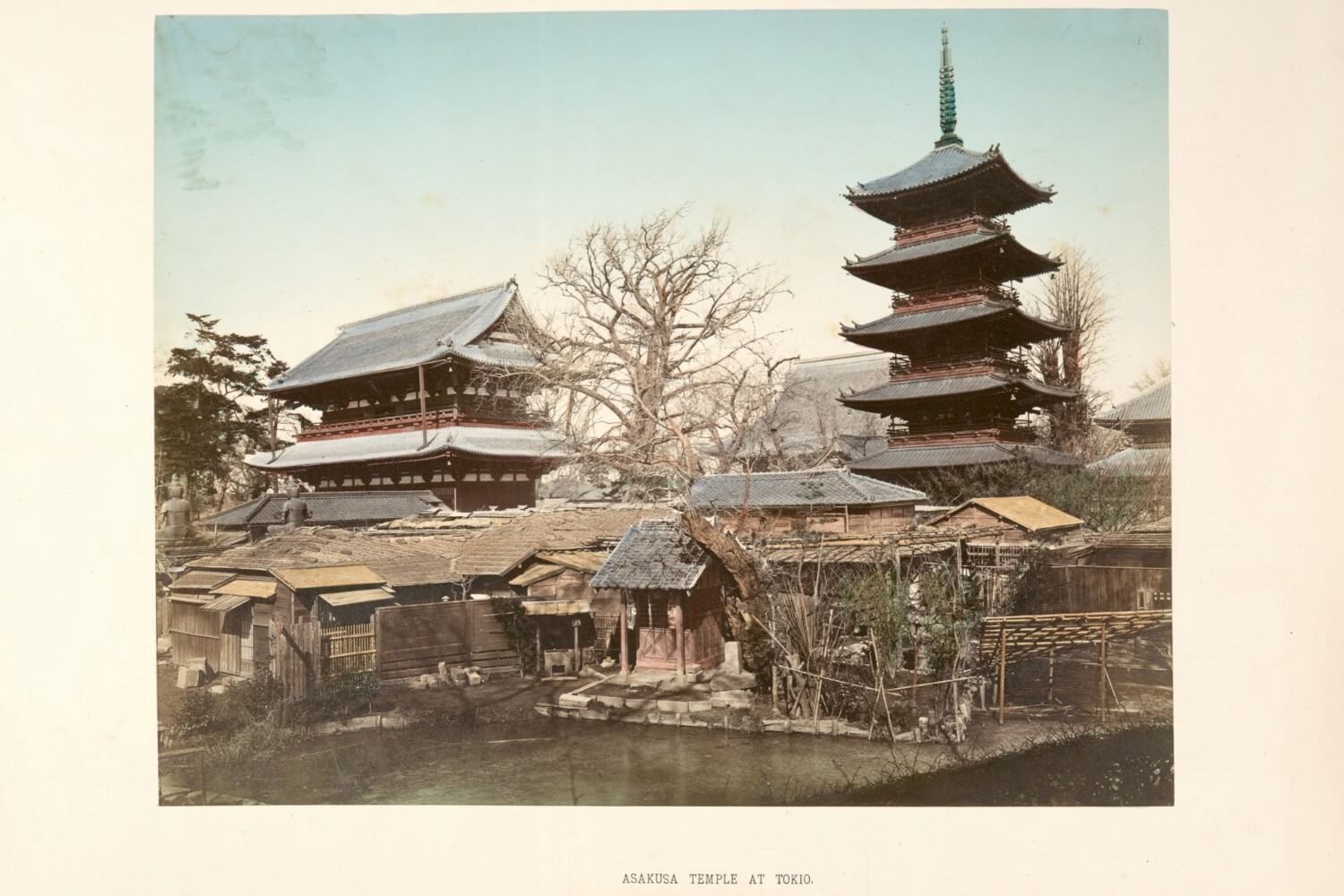
(Source photo: From The New York Public Library, photographer Kimbei, Kusakabe)
Is this really the oldest temple of Tokyo?
The Sensoji Temple may have its origins in the year 645, but most of the buildings were built after the Second World War. The air raids hit Tokyo so hard that most of the complex was destroyed.
Behind the prayer hall, you will find the Asakusa Jinja Sanctuary from 1649. This building is dedicated to the two brothers who found the golden Kannon. Also, the Nitenmon gate dates back to 1618. It was the original entrance to the Sensoji Temple. Today, the Kaminarimon gate is considered to be the real entrance to the complex.
Sightseeing – What to see and do at the Sensoji Temple?
The Sensoji Temple is located in Tokyo’s nicest district, Asakusa. In this district alone you can spend a whole day. But the main attraction is definitely the Sensoji Temple, also called the Asakusa Kannon Temple. Below you can read more about the main attractions in this area.
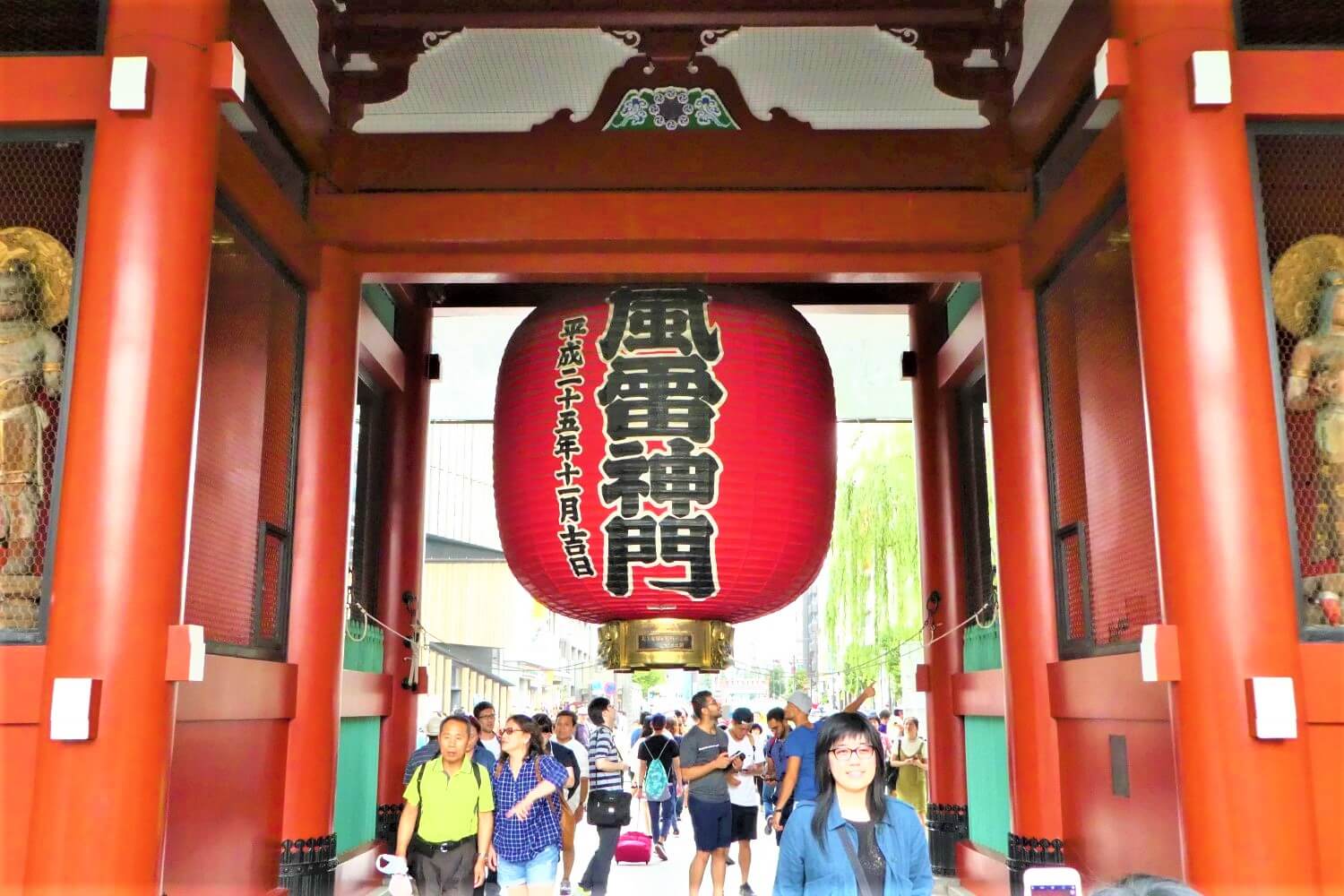
The Kaminarimon Gate, the gateway to the Sensoji Temple
Upon arrival at the south end, you will find the Kaminarimon Gate. It was donated by Japanese businessman Konosuke Matshushita (1894-1989), founder of Panasonic. He was around 50 when doctors told him he did not have long to live. He regularly went to the Sensoji Temple to pray and hope for a miracle. And indeed, Matshushita was healed of his incurable disease. In gratitude, he donated to the Sensoji Temple the Kaminarimon Gate.
The most striking part of this gate is the lantern. It is no less than 4 meters high and weighs more than 500 kilos. When you take a close look at it, you’ll see the lantern has the name Matsushita on it. Every ten years the heavy red object is replaced by the company Panasonic.

Nakamise-Dori: buy souvenirs in Tokyo’s oldest shopping street!
This is Another reason why you shouldn’t skip the Sensoji Temple. Here you will find the Nakamise-Dori. This is a very nice, but touristic shopping street of 250 meters long and 90 shops. Everything you need from Japan can be bought here. From omamori (Japanese amulets), kimonos, swords of the samurai to sushi, yakitori, and noodles.
As early as the 18th century there were several shops here, making this street one of the oldest in Tokyo. But don’t let yourself be overwhelmed by the number of tourists. Take your time, because this is a great place to buy souvenirs or eat typical Japanese food.
History: Until 1945 Asakusa was the entertainment district of Tokyo. Because of the air raids during the Second World War, many buildings in Asakusa are not older than 50 years.

The Hozomon Gate and the treasury of precious sutras
Finally, on the second floor of the Hozomon Gate, there is a Treasury containing a number of important sutras from the 14th century. A sutra consists of one or more aphorisms. I’m sorry? aphorisms ?? Okay… these are statements that contain a message of wisdom. Clear?
Unfortunately, it is not possible to visit the treasury, but it is an important cultural heritage because of these sutras. Finally, next to the Hozomon gate, there is a five-story pagoda. It has only a short history that began in 1973. It contains drawings and figurines but is closed to the public for most of the year.
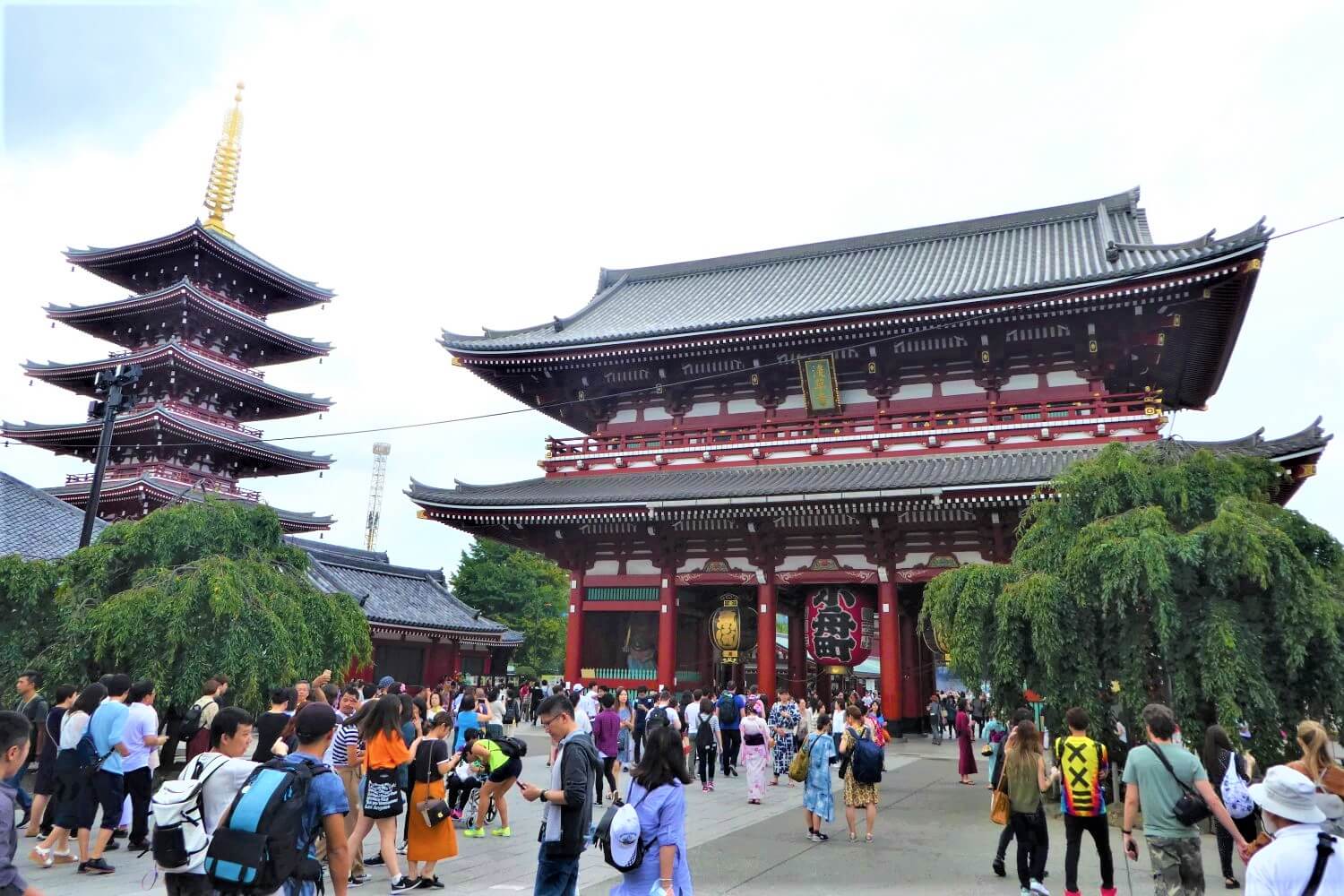
The prayer hall with the Golden Kannon?
Finally, you will arrive at the prayer hall. Before you go in, take some incense to yourself. This will ensure good health. Once you’re inside the main building of the Sensoji Temple, you’ll see mostly gold! But the Golden Kannon? You won’t see that one, and it’s also questionable whether the statue exists.
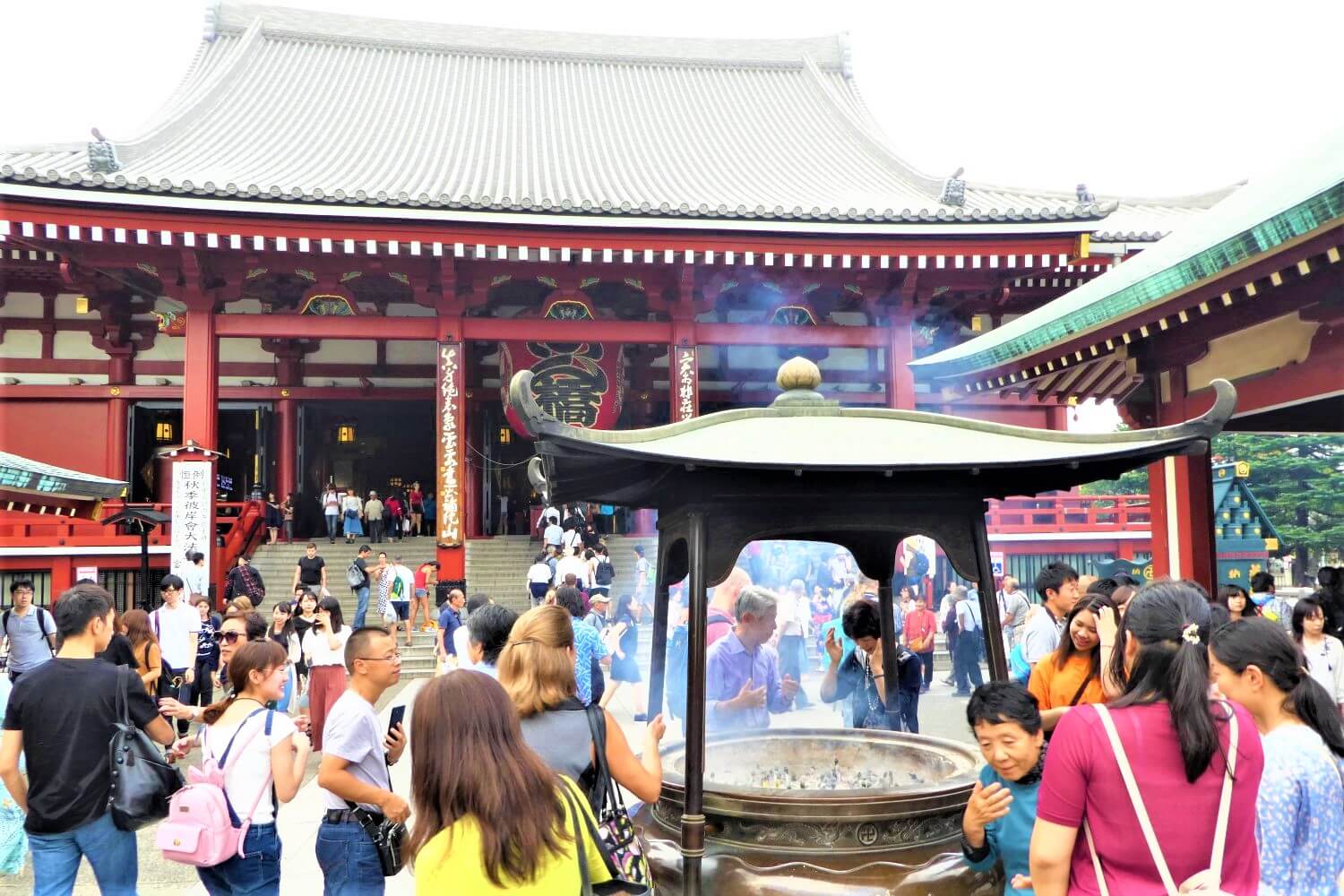
Discover the garden of the Asakusa Kannon Temple
Finally, you can take a walk around the grounds. If you do, don’t forget to visit the Asakusa Jinja Shrine and the Nitenmon Gate. These are the oldest buildings on the grounds.
You will also find a beautiful garden with statues, lanterns, goldfish and beautiful trees and plants. The garden is not large, but it is interesting to have seen.
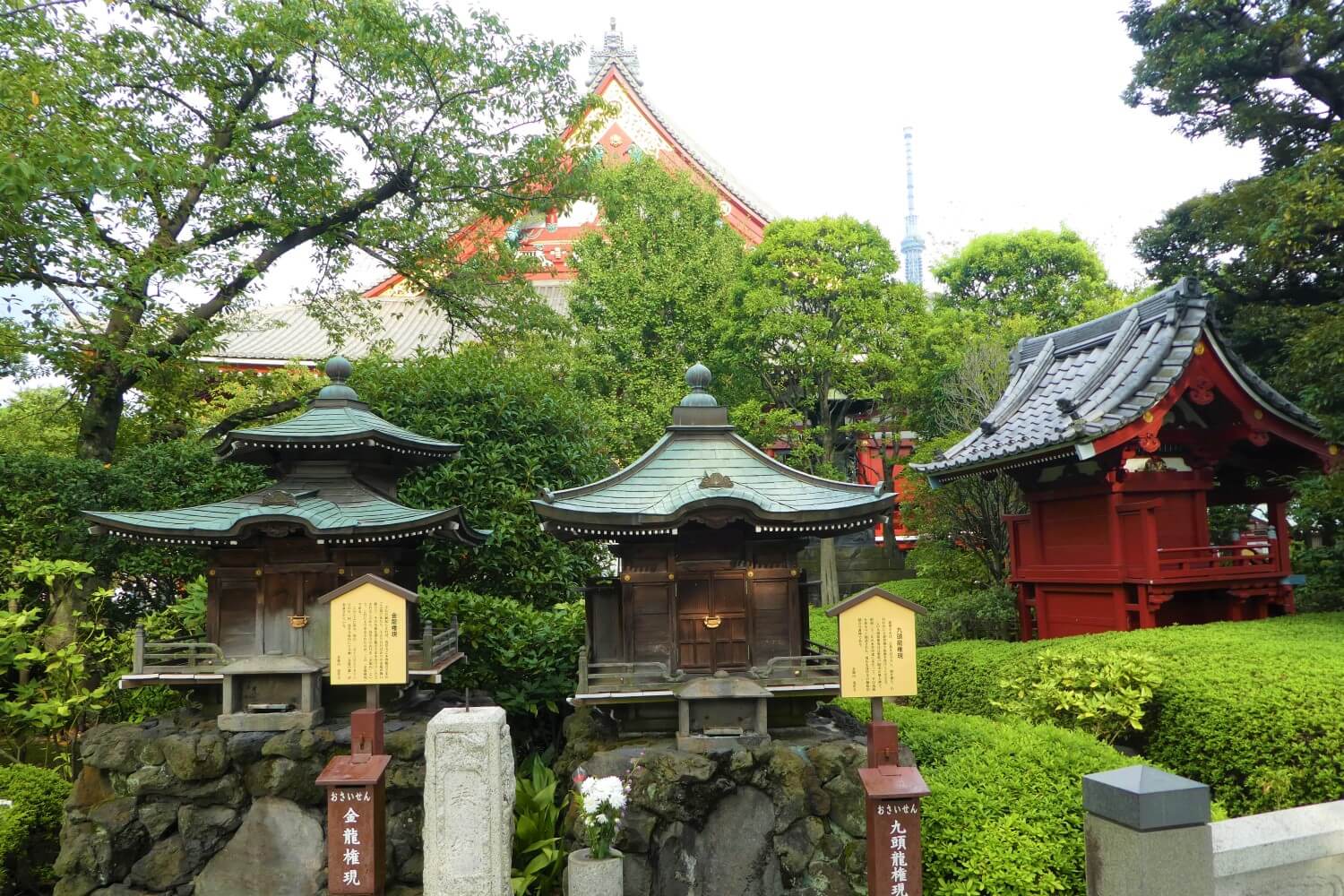
The Sensoji Temple? Worth a visit?
The Sensoji Temple is touristy and quite crowded. You can get around this by visiting late in the evening. The buildings may be closed, but this way you can still catch a glimpse of this beautiful temple. Because it is certainly beautiful.
I stayed here for about 2 hours. In Nakamise-Dori you can buy very nice souvenirs. But all those tourists? Yes, that is the only drawback of this attraction. But the history, beauty and experience of the Asakusa district makes up for a lot.
Planning to stay overnight in the Asakusa district? It’s a great idea! Then consider spending a few nights in a Ryokan. This is a typical Japanese hotel, where you may have to spend the night on a futon. A futon is a thin mattress on the floor. Check here for Ryokans in Tokyo.

Practical Information about the Sensoji Temple in Tokyo?
How to get to the Asakusa Kannon Temple? The Sensoji Temple is located in Asakusa, the historical neighborhood of Tokyo. It is accessible by subway on the Ginza-line, station Asakusa in the south of the temple.
Metro City Card: Tokyo is best discovered by subway. Therefore, if you want to see a lot in a short time, it is convenient to purchase the Tokyo Metro Pass for 24, 48 or 72 hours. Look here for more information.
Opening hours? Although you can visit the complex all day long, the main hall is open daily from 6 am till 5 pm. The Entrance is free.
Maybe also interesting?
- Sightseeing Tokyo? The 15 best historical attractions
- Tokyo, Japan | Travel Guide of History to an Amazing Metropolis
- Hachiko Shibuya | Amazing true Story of a Japanese Dog
- Meiji Jingu Shrine | Visit the Memorial of Emperor Meiji
- Imperial Palace | Follow the Road along the former Edo Castle
Do you have more information, tips, or remarks about the Sensoji Temple in Tokyo, Japan? Please feel free to leave a message below!